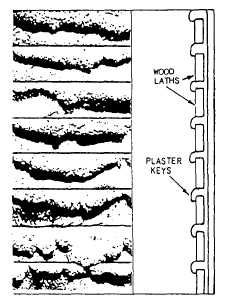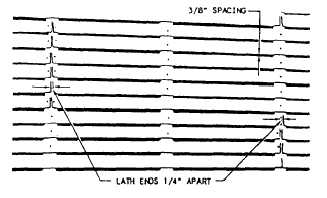cling—the plaster base. A continuous concrete or
masonry surface may serve as a base without further
treatment.
BASES
For plaster bases, such as those defined by the inner
edges of the studs or the lower edges of the joists, a base
material, called lath, must be installed to form a
continuous surface spanning the spaces between the
structural members.
Wood Lath
Wood lath is made of white pine, spruce, fir,
redwood, and other soft, straight-grained woods. The
standard size of wood lath is 5/16 inch by 1 1/2 inches
by 4 feet. Each lath is nailed to the studs or joists with
3-penny (3d) blued lathing nails.
Laths are nailed six in a row, one above the other.
The next six rows of lath are set over two stud places.
The joints of the lath are staggered in this way so cracks
will not occur at the joinings. Lath ends should be spaced
1/4 inch apart to allow movement and prevent buckling.
Figure 7-1 shows the proper layout of wood lath. To
obtain a good key (space for mortar), space the laths not
less than 3/8 inch apart. Figure 7-2 shows good spacing
with strong keys.
Wood laths come 50 to 100 to the bundle and are
sold by the thousand. The wood should be straight-
grained, and free of knots and excessive pitch. Don’t use
old lath; dry or dirty lath offers a poor bonding surface.
Lath must be damp when the mortar is applied Dry lath
pulls the moisture out of the mortar, preventing proper
setting. The best method to prevent dry lath is to wet it
thoroughly the day before plastering. This lets the wood
swell and reach a stable condition ideal for plaster
application.
Figure 7-1.—Wood lath with joints staggered every sixth
course.
Figure 7-2.—Wood lath, showing proper keys.
Board Lath
Of the many kinds of lathing materials available,
board lath is the most widely used today. Board lath is
manufactured from mineral and vegetable products. It
is produced in board form, and in sizes generally
standardized for each application to studs, joists, and
various types of wood and metal timing.
Board lath has a number of advantages. It is rigid,
strong, stable, and reduces the possibility of dirt filtering
through the mortar to stain the surface. It is insulating
and strengthens the framework structure. Gypsum board
lath is fire resistant. Board lath also requires the least
amount of mortar to cover the surface.
Board laths are divided into two main groups:
gypsum board and insulation board. Gypsum lath is
made in a number of sizes, thicknesses, and types. Each
type is used for a specific purpose or condition. Note:
Only gypsum mortar can be used over gypsum lath.
Never apply lime mortar, portland cement, or any other
binding agent to gypsum lath.
The most commonly used size gypsum board lath is
the 3/8 inch by 16 inches by 48 inches, either solid or
perforated. This lath will not burn or transmit
temperatures much in excess of 212°F until the gypsum
is completely calcined. The strength of the bond of
plaster to gypsum lath is great. It requires a pull of
864 pounds per square foot to separate gypsum plaster
from gypsum lath (based on a 2:1 mix of sand and plaster
mortar).
7-4



